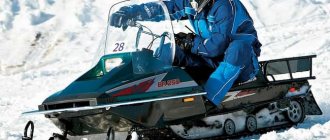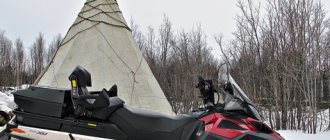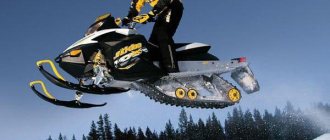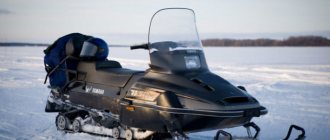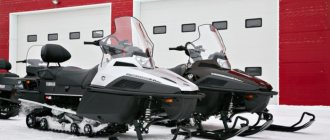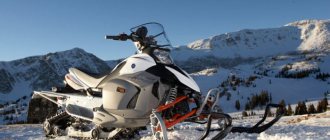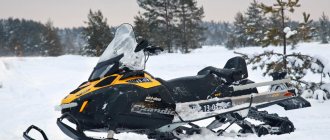Thanks to its powerful engine, the Yamaha Bravo 250 T snowmobile is perfect for hard work. The utilitarian model has a simple and reliable design. Wide tracks and low weight allow the equipment to pass through the most difficult places along with a trailer.
Externally, the model looks angular, which speaks of a rich history. The first Bravo series snowmobiles appeared back in 1982. Global restyling took place in 1992. From that moment on, the design of the snowmobile remained virtually unchanged. It is these familiar features that set the Bravo series apart from other products. The consistency of the design only speaks of its efficiency and high quality.
In terms of design, the snowmobile is very simple: a durable steel frame, a reliable 2-stroke unit, suspension on semi-elliptical springs and a manual starter. Only the speedometer and odometer are displayed on the dashboard. The Yamaha Bravo 250 T does not have a reverse gear - its small weight allows you to lift and move the snowmobile manually by grasping the tubular “rail” or trunk guard. The parking brake uses a brake lever on the handlebar, which is secured with a simple latch.
Video
The basic configuration for cold countries (Russia is one of them) comes with a primer (additional fuel injection pump), which allows the pump from the instrument panel to inject fuel directly into the receiving manifold. Thanks to this, it is possible to start the engine in any weather conditions. On the left behind the glass there is a variator covered with a casing, on the right there is a capacious gas tank and brake. In the engine compartment there is a small box with road tools and an emergency start cord.
The opinion that you should not do anything yourself with foreign technology does not apply to the Yamaha Bravo 250 T. Without special training, the driver can reach almost any node, performing maintenance without the help of a specialist.
In terms of driving performance, the model is among the leaders. The Yamaha Bravo 250 T confidently overcomes climbs and takes sharp turns without skidding. According to the passport, the snowmobile is designed for only one person. But in terms of trunk volume, the equipment will surpass most competitors.
Yamaha Bravo 250 T is a reliable and affordable snowmobile made in Japan. The model has a low price and according to this indicator is an excellent alternative to Russian analogues. The equipment is perfect for beginners, and low fuel consumption will allow you to cover long distances without refueling. Harsh conditions are not scary for the Yamaha Bravo 250 T model; a simple and unpretentious snowmobile is capable of performing the most complex tasks.
Manufacturer country
The birthplace of the legendary all-terrain vehicle is the land of the rising sun - Japan. Many people are accustomed to trusting Japanese-made technology, be it a game console or a car. And this is no coincidence, because even models from the 90s still drive great today. At the same time, if you believe the reviews of the owners, they practically do not break.
When the company appeared
The company received its name in honor of the founder Torakusu Yamaha, who in 1887 opened the Nippon Gakki Co. plant, which initially specialized in the production of harmoniums. A hundred years later, the company was renamed to the well-known Yamaha Corporation.
First motorcycle
Since the twenties of the last century, the company began to produce aircraft parts. The first motorcycle rolled off the assembly line in 1954. Production continued for a year, during which time 125 units of equipment were produced. After such tremendous success, management decided to split the company. This is how two independent corporations appeared - Nippon Gakki and Yamaha Motor.
Characteristics of the main elements:
Chassis:
- front suspension type – leaf spring;
- front suspension travel – 100 mm;
- type of front shock absorbers - hydraulic;
- rear suspension type – Slide Rail;
- rear suspension travel – 100 mm;
- type of rear shock absorbers - hydraulic KYB;
- frame material – steel.
There is no anti-roll bar in the Yamaha Bravo 250 T model; skates with carbide inserts are optionally available.
Transmission:
- clutch – variator;
- transmission – variator;
- number of speeds – 1 (no reverse);
- braking system – mechanical single-disc;
- the starting system is manual.
Additional devices:
- electric starter – absent;
- heated steering wheel grips – optional;
- mirrors – optional;
- seat back – missing;
- tow bar – present as standard;
- trunk - present as standard;
- oil level indicator – missing;
- high beam indicator – absent;
- speedometer (odometer) – present in the basic configuration;
- tachometer – missing.
The snowmobile can accelerate to 80 km/h.
What is it best suited for?
The Yamaha Bravo snowmobile can rightfully be considered a legend of the Japanese motorcycle concern. The first copy was released back in 1982. Almost immediately, the device gained fame as an easy-to-use and reliable utility. In this sense, it can be compared with the domestic all-terrain vehicle "Taiga".
Initially, the snowmobile had a short platform and a small luggage compartment. In 1992, the model underwent some changes. After restyling, the all-terrain vehicle took on the well-known forms by which we recognize it. In 2011, the snowbike was discontinued.
This brave snowbike is perfect for amateur riding. Lightweight and maneuverable, it is ideal as a first snowmobile. Thanks to its simple design, the driving skills of novice “bikers” manifest themselves quite quickly.
Engine
The Yamaha Bravo 250 T is equipped with a 2-stroke engine designed specifically for this snowmobile. The Japanese motor has a huge service life. The power plant has a large power reserve and forced air cooling. The power plant is started manually.
Engine characteristics:
- working volume – 249 cc;
- rated power - 18 hp;
- number of cylinders – 1;
- cylinder diameter – 60 mm;
- recommended fuel type - AI-95 gasoline;
- fuel system – Keihin BD32-28.
The main fuel tank of the snowmobile holds 15 liters of fuel. One full refueling is enough for approximately 100-130 km (average fuel consumption is 11-15 l/100 km). A large additional tank of 9.3 liters is also provided. It is located on the front panel next to the oil tank (1.8 l). To control the oil and gasoline levels, special transparent tubes are used.
Advantages of the model
Despite the lack of some of the amenities that are inherent in most modern snowmobiles, this track has a number of positive qualities. These include:
- Large trunk (open and under the seat). Typical for a single-seat model.
- Long track base. Allows you to navigate even the most difficult places and deep snow.
- Durable front bumper.
These features are highlighted by the manufacturer himself. Owners and lovers of all-terrain vehicles also note other advantages:
- relatively small dimensions;
- small mass;
- good build quality and parts;
- affordable price.
As a summary, we can say that this bike is quite fast and maneuverable, and is also undemanding to operate.
Price
The cost of the Yamaha Bravo 250 T model without mileage starts from 300,000 rubles. However, it is unlikely that you will be able to buy a snowmobile in new condition.
There are quite a lot of used offers of this snowmobile on the domestic market. The final price tag here is determined by the mileage and condition of the equipment.
Average cost on the market:
- 1995-1996 – 110,000-160,000 rubles;
- 2004-2005 – 190,000-210,000 rubles;
- 2009-2010 – 250,000-280,000 rubles.
How much does a snowmobile cost?
The cost of the new Yamaha Bravo 250 is 275,000 Russian rubles. Official dealers of the manufacturing company provide sales and fast delivery to all cities of the Russian Federation and neighboring countries. Delivery in Moscow and the nearest Moscow region is free; for other regions, the cost of postal or courier services must be added to the price of the snowbike (on average +1500-3500 rubles).
A used model can be bought for 255,000 - 268,000 rubles. depending on the number of operating hours and general technical condition. A used Bravo 250 usually requires repair. Here are approximate prices for some spare parts suitable for this winter bike (cost in rubles):
| Fuel tank | 12 190 |
| Seat back | 25 600 |
| Fuel filter | 570 |
| Piston rings | 1 700 |
| Gear shift lever | 1 550 |
| Brake disc | 5 250 |
| Windshield | 5 780 |
| Complete carburetor assembly | 25690 |
| Fully assembled hood | 52100 |
Owner reviews
- Vitaly, Nizhny Novgorod: I bought a Yamaha Bravo 250 T from a friend for 200,000 rubles. The model has a short-travel suspension, but it absorbs road irregularities well, due to which the movement remains smooth even at high speed. When turning, the snowmobile feels less confident and may fall outward. I encountered a similar situation several times. The reason for this is the small track and low weight. The disadvantage of a narrow gauge turns into an advantage when it is necessary to drive through a gap between trees or hillocks. When driving on snow, the equipment does not fall through. Yamaha Bravo 250 T is true Japanese quality. For 3 years I have not experienced any problems with the snowmobile. The main disadvantages are the old design and instability when cornering.
- Nick_name: Yamaha Bravo 250 T is a simple and affordable snowmobile with good build quality. I have owned it since 2010. Driving the vehicle is very comfortable. Good wind protection and a large windshield cut off snow and wind, allowing you to fully concentrate on the road. Initially, the steering seemed uncomfortable, but I quickly got used to it, and now I can easily perform various maneuvers. The Japanese quality of the model speaks for itself: no distortions, unnecessary details or defects, everything is done in the best possible way. The only drawback of the snowmobile is the lack of reverse.
- Snowmobile user: Dynamic and inexpensive machine that works well in Russia. The Yamaha Bravo 250 T snowmobile has been in personal use for almost 5 years, I recommend this model to everyone. Despite the foreign assembly, spare parts and components in the event of a breakdown could be found fairly quickly. On the first trips it seemed that the skis were a little unfinished, which is why the stability was very low. However, he soon adapted to this situation. The snowmobile's engine is very playful; it just jumps up hills. A significant disadvantage is the lack of reverse gear. I got out of this situation like this: I got up from the snowmobile and turned it around (fortunately, its light weight allowed me to do this).
- Dima Khomchenko: Yamaha Bravo 250 T is a comfortable and lightweight snowmobile. My dad and I use it for hunting and fishing. I like the low fuel consumption and the ability to move on any snow without failures. The snowmobile can pull a large load, the car pulls very well. There is no reverse, but this is not a serious problem, since the small mass allows you to simply move the equipment, placing it in the desired direction. A little prone to falling over, you just need to get used to the driving style. Doesn't start well at low speeds. But in terms of quality, the Yamaha Bravo 250 T is the best model I have used.
Do-it-yourself carburetor adjustment
- Unscrew the spark plugs and make sure they are in good condition. If they are flooded or have heavy carbon deposits, the part must be replaced.
- Set the free play of the throttle valve drive. The working play should be at the level of 1 - 2 mm.
- Clean the air filter. The amount of air supplied depends on the condition of the element. Do not adjust idle speed with a clogged filter.
The idle speed is adjusted using two screws - one is responsible for quality, and the second for quantity. Initially, all adjustments are made on a cold engine. In the warmed-up state, the final calibration is performed. Quality screw (yellow, made of bronze). To adjust it, you need to tighten it completely and then unscrew it exactly 1.25 turns. Next, you need to warm up the motor and use the quantity screw (white, plastic) to set the minimum number of revolutions at which the motor runs without interruption (usually 900 - 950 rpm).
Important! Adjusting the idle speed of the Yamaha Viking 540 snowmobile, after running in or for other operating conditions (driving in the mountains or in severe frost), is performed purely individually. There is no universal screw position for all conditions!
Note. The idle speed setting is only relevant up to ¼ throttle lift. Therefore, to reduce fuel consumption it is necessary to select less efficient jets. But this must be done extremely carefully, since a strong reduction in the cross-section is fraught with depletion of the mixture and, as a result, frequent overheating of the power unit.
